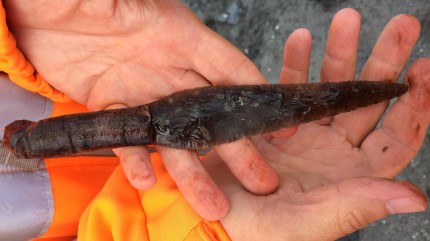Archaeologists from the Museum Lolland-Falster discovered a flint dagger with a bark-wrapped hilt while surveying a site in southern Zealand that will be a part of the Fehmarn Belt Link, an underwater tunnel connecting Germany and Denmark. The dagger is about 3,000 years old, dating to the Early Bronze Age, a time when bronze was replacing flint as the blade of choice. During this transitional period, bronze was still hard to come by and when it wasn’t available, artisans made daggers with flint blades incorporating the new hilt technology used in bronze pieces.
Examples of this rare combination of Stone and Bronze Age have been discovered before in Germany, but this is the first time one has been found in Denmark. The German ones were found in graves as daggers were valuable and their owners kept them even unto death. The Zealand dagger was found in an ancient seabed. The waterlogged environment preserved the delicate organic material.
“A hilt dagger of this type never before found in Denmark. We know the type, but to find such a magnificent specimen of a hilt is absolutely fantastic. Enthusiasm was enormous, as the dagger suddenly appeared after the excavator had removed the overlying layers. But when we removed it and saw that parts of a bark hilt was preserved almost intact, we thought the excitement never ends,” says a smiling Anders Rosendahl, archaeologist at the Museum Lolland-Falster.
The dagger is about eight inches (20 cm) long and made from a single piece of charcoal grey flint that is in exceptional condition. The hilt is wrapped in layers of birch bark to make it easier (and less dangerous) to hold.
The same day it was found, the dagger was sent to the National Museum in Copenhagen to ensure its conservation. Researchers hope that the conservation and study of the bark will be able to answer some questions about the dagger, like where it was made.

(Yes, that does look way more like obsidian, but every source, including the museum website, calls it flint so I’m going with that.)
Obsidian indeed.
I didn’t understand the word flint for a long time when I was a child, until I grew up and learned that western US rockhounds often used the word to mean any hard rock that fractured to sharp edges and could be worked. What is usually called flint, we called chert. No idea how or if this usage crosses language barriers. I have a fantasy that if I keep trying to read Danish, eventually I will understand it. Hasn’t worked yet, and machine translation gives no clues. If this knife is obsidian, then the find is especially lucky, because obsidian is a softer rock than chert/flint. It scratches and breaks relatively easily in comparison. I have to admit that the piece looks obsidian. I have no doubt that soon we will know for sure.
Flint is chemically the same as chert, and the word generally refers to nodules of chert found embedded in chalk. Chalk-flint is often a very dark colour once the white outer layer is removed, and will look very much like obsidian when photographed.
We live on a clay soil with lots of small flints in it. Some we collect for their beauty. Some we suspect of having been worked: could something so like an arrowhead really be natural, we ask ourselves? Or so like a cutting blade?
Our road is a Roman Road, and therefore probably also an Iron Age Road, perhaps a Bronze Age road, and maybe a Neolithic road. It could even have been a mesolithic track I suppose. Who knows?
It’s chert or flint, whichever you prefer.
Geologically, obsidian is a volcanic glass, formed during eruption, whereas chert/flint is made of lithified silica critters (radiolaria, usually) deposited in a deep ocean environment. Flint is a much more stable rock (neither is a mineral) than obsidian, which is really is glassy and more prone to shatter. (Now that I think of it I’m curious if any of those blades are really true obsidian, since very often the archeological names of materials do not correspond completely with geologic terms.)
This is indeed flint! Trust me, I’m a dane, and we do not have obsidian over here.